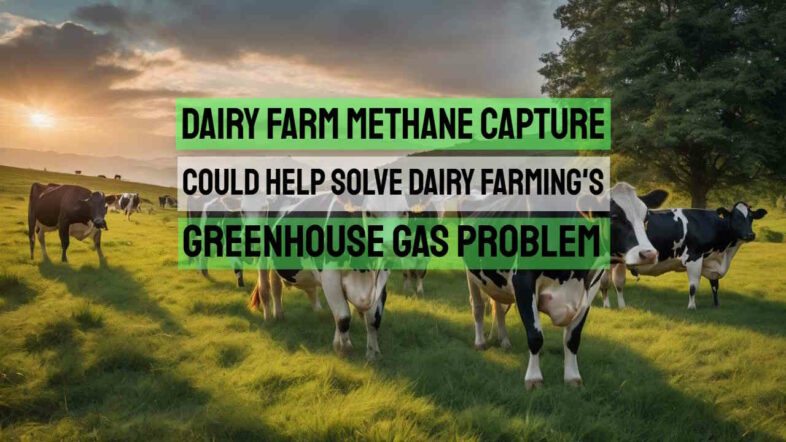This article explains dairy farm methane capture, and it’s an important read because methane capture on dairy farms has the potential to end dairy farming’s contribution to climate change and warming gas emissions.
Farmers worried that governments may soon move to limit dairy farming and meat production in order to combat climate change should read and implement the strategies described in this article and take action.
Enteric methane from dairy farms is a significant contributor to greenhouse gases. Can you believe that in many nations, farmers are making a profit by capturing this methane from cow manure?
[boomdevs_toc]
In this post, we will explore the fascinating process of dairy farm methane capture and its various benefits.
Intrigued? Then read on for an insight into innovative farming practices with far-reaching impact.
Key Takeaways
- Dairy farm methane capture using the anaerobic digestion process reduces greenhouse gas emissions by capturing methane from cow manure, helping to combat climate change.
- Implementing basic methane capture technology on dairy farms can lead to financial incentives and savings on diesel costs, improving the economic sustainability of the industry.
- Changes in cow management practices, such as adjusting diets and improving manure management, contribute to reducing methane emissions and promoting sustainable farming practices via biogas production and also making a natural fertilizer for farm use.
The Benefits of Dairy Farm Methane Capture
Dairy farm methane capture offers reduced greenhouse gas emissions, financial incentives, and savings on diesel costs, as well as improved sustainability and environmental stewardship.
Reduced greenhouse gas emissions
Cutting down greenhouse gases is a huge plus of dairy farm methane capture. Methane from cow waste adds to these harmful gases. Farms now catch this gas before it goes into the air.
They use special tools called methane digesters to do this work. This helps lessen the harm done by cow methane emissions to our world’s weather and to the health of natural ecosystems. It cuts down on the amount of carbon sent out by farms, making them cleaner places.
Financial incentives and savings on diesel costs
Dairy farmers who invest in methane capture technology can benefit from financial incentives and save on diesel costs. In California, tougher limits on greenhouse gas emissions are encouraging dairy farms to adopt this technology.
By capturing the methane emitted by cow manure, farmers can earn additional income through programs that reward them for reducing their carbon footprint. Additionally, using captured methane as an alternative to diesel fuel can help lower operating costs for farm equipment such as tractors.
This not only improves sustainability and environmental stewardship but also contributes to savings on fuel expenses for dairy farmers. Overall, implementing methane capture technology provides both economic and environmental advantages for the dairy industry while helping to mitigate climate change impacts.
Improved sustainability and environmental stewardship
Dairy farm methane capture plays a crucial role in improving sustainability and environmental stewardship. By capturing methane emissions from cow manure, dairy farmers can significantly reduce their carbon footprint and contribute to climate change mitigation.
This helps in creating a more sustainable farming system that is environmentally friendly.
Implementing methane capture technology on dairy farms also demonstrates a commitment to environmental stewardship. It shows that farmers are taking proactive steps to minimize pollution and maximize resource efficiency.
By investing in this technology, dairy farmers are not only reducing greenhouse gas emissions but also utilizing renewable energy sources for power generation.
How Dairy Farmers are Implementing Methane Capture
Dairy farmers are implementing methane capture by making changes in cow management practices and investing in methane harvesting technology.
The process of capturing methane from cow manure
Dairy farmers are finding ways to capture methane from cow manure. Here’s how they’re doing it:
- Using methane digesters: These devices collect and process the manure, breaking it down in an oxygen-free environment. This process produces biogas, which is mostly made up of methane.
- Storing the biogas: The captured biogas is stored in tanks or containers where it can be used for various purposes. This includes capturing the biogas bubbling up from the bottom of slurry lagoons with floating plastic balloons.
- Generating electricity: Some dairy farms use the captured biogas to generate electricity. This can power the farm itself or be sold back to the grid.
- Producing heat: The captured biogas can also be used for heating purposes, such as heating buildings or water.
- Reducing odors and pathogens: Methane capture not only reduces greenhouse gas emissions but also helps control odors and kill harmful pathogens found in manure.
- Improving manure management: By capturing methane, dairy farmers can manage their manure more effectively, reducing potential environmental pollution.
Changes in cow management practices
Dairy farmers are making changes in cow management practices to reduce methane emissions and improve environmental sustainability. Here are some of the key changes being implemented:
- Adjusting cow diets: Farmers are modifying feed to reduce the formation of methane in cows’ digestive systems. This can involve using different types of feed or adding supplements that help to break down food more efficiently.
- Implementing better manure management: Dairy farmers are employing strategies to handle and store manure in a way that minimizes methane emissions. This includes methods such as covered storage, anaerobic digestion, and separating solid and liquid waste.
- Improving barn ventilation: Proper ventilation can help reduce the accumulation of gases like methane inside barns where cows are kept. Farmers are investing in improved ventilation systems to ensure good air quality for their animals while also minimizing greenhouse gas emissions.
- Monitoring cow health and genetics: Keeping cows healthy is important for reducing methane production. Farmers are using genetic selection and breeding programs to produce cows with traits that result in less enteric methane during digestion.
- Utilizing advanced technology: Modern technologies such as wearable devices and sensors allow farmers to monitor individual cows’ behavior, feed consumption, and overall health. This helps identify potential issues that may contribute to increased methane emissions, allowing for proactive interventions.
Investment in methane harvesting technology
Dairy farmers are investing in methane harvesting technology to reduce greenhouse gas emissions and improve sustainability. Methane digesters, for example, are being used on farms to capture and process methane emissions from livestock manure.
This technology helps reduce the environmental impact of dairy farms by capturing and processing methane, a potent greenhouse gas. By implementing this technology, farmers can contribute to climate change mitigation efforts while also improving their farm’s sustainability and reducing their carbon footprint.
Blunt talk About Cow Methane Emissions from a Yorkshireman
We’re talkin’ about dairy farms and keepin’ those pesky greenhouse gases in check, they’ve got a couple more tricks up their sleeves.
Livestock Programs: First off, they’re runnin’ these livestock programs, aimin’ to put a cork in methane emissions from the rear end of the cows. They’re sortin’ out the cows’ diets, you see, which can help cut down on all that methane coming out the back. It’s a bit like givin’ ’em a special recipe to keep things under control!
Dealing with the Barn Mess: Now, inside them barns and them slurry lagoons, things can get a bit messy, and there’s this methane sneakin’ out during the decomposition process. But clever dairy farmers, they’re buildin’ and runnin’ these biogas plants. These contraptions catch that methane and put it to work, makin’ energy. So, not only are we reducin’ methane in the air, but we’re also puttin’ it to good use. That’s what I call a win-win, my friend!
These investments not only benefit the environment but also support financial returns as dairy farms in California, and in may other locations, have found profitable opportunities through methane capture technology.
Economic and Environmental Impacts of Methane Capture
Methane capture on dairy farms has significant economic and environmental impacts, reducing greenhouse gas emissions and contributing to climate change mitigation. Read on and learn more about the financial returns and sustainable progress in the dairy industry.
A Fine Way to Make Use of CO2 in Raw Biogas
I’ve got a tale to tell about a mighty fine way to deal with that carbon dioxide in raw biogas. You see when we’re separating the methane from the CO2 during the biomethane production process, it’s like unearthing treasure. But don’t forget, we’ve got to take care of that CO2 too!
Purifying the CO2 is the name of the game. It’s a bit like sifting for gold in a river of mud. By purifying that CO2, we’re not only making the methane cleaner, but we’re also doing our bit to tackle that pesky greenhouse gas.
So, next time you hear about folks separating methane from raw biogas, remember, it’s not just about the treasure – it’s about making sure the Earth stays green and clean. That’s the kind of work that keeps our engines chugging and our skies clear. Cheers to capturing that CO2, my friends!
Financial returns and compromises
Dairy farm methane capture can bring both financial returns and compromises. On the one hand, capturing methane emissions from dairy farms can lead to opportunities to apply for government financial incentives and simultaneously make savings on diesel costs.
Methane captured from cow manure can be used as a renewable energy source, which reduces reliance on tractor fuel and lowers operating costs. Additionally, some EU and US states now offer financial incentives to dairy farmers who invest in methane capture technology.
On the other hand, implementing methane capture requires an investment in equipment and infrastructure. This initial cost may be a compromise for some farmers, but it is often outweighed by the long-term benefits of reduced greenhouse gas emissions and improved sustainability.
Contribution to climate change mitigation
Dairy farm methane capture plays a significant role in mitigating climate change. Methane, a potent greenhouse gas, is emitted by livestock through belching and manure decomposition.
By implementing methane capture technology, dairy farmers can reduce these emissions and their carbon footprint. This not only helps to protect the environment but also contributes to global efforts in combating climate change.
The captured methane can be converted into renewable energy, further reducing reliance on fossil fuels. With the increasing focus on sustainability and environmental stewardship, dairy farms that invest in methane capture technology are making a positive contribution towards climate change mitigation.
Sustainable progress in the dairy industry
The dairy industry is making sustainable progress by implementing methane capture technology and adopting environmentally friendly practices. By capturing methane emissions from cow manure, dairy farms are reducing their greenhouse gas emissions and mitigating climate change.
This not only helps to improve the environmental sustainability of the industry but also contributes to a farm’s financial returns by saving on diesel costs and generating renewable energy.
With the use of methane digesters and other technologies, dairy farmers can make a significant impact in reducing their carbon footprint while ensuring the long-term viability of their operations.
A Conclusion to Dairy Farm Methane Capture
In conclusion, dairy farm methane capture plays a crucial role in reducing greenhouse gas emissions and promoting sustainable farming practices. By implementing methane capture technology and making changes in cow management practices, dairy farmers can not only save on diesel costs but also contribute to climate change mitigation.
Methane capture is a win-win solution for both the environment and the dairy industry’s economic sustainability.
Dairy Farm Methane Capture FAQs
1. What is dairy farm methane capture?
Dairy farm methane capture is a way to reduce pollution and carbon footprint from cows by using things like a dairy digester facility (also confusingly called a “digester plant”!).
2. How can cow manure be used in biogas production?
Biogas production uses livestock waste management that changes cow manure, into energy. This helps to lessen greenhouse gases in the atmosphere and to lower agricultural carbon emissions in general.
3. Can this method help control livestock emissions?
Yes, it does! With slurry management and other ways of handling animal waste, we can cut down on livestock emissions as part of your methane reduction strategies.
4. How does Dairy Farm Methane Capture help the environment?
By cutting down on the amount of cow methane released into the air, we’re able to lessen our effect on climate change by reducing greenhouse gas emissions.









